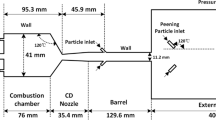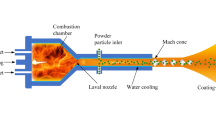Abstract
High velocity oxygen fuel process (HVOF) involves supersonic two-phase flow of gas-solid particles. Two kinds of shocks are formed in a typical high velocity oxygen fuel process. Adjustment of the overexpanded flow to the atmospheric pressure at the exit of the nozzle results in formation of shock diamonds while high speed flow impingement on a substrate creates bow shock. The latter is found to be responsible for deviation of the injected particles from their trajectories near the substrate, which significantly reduces the chance of some particles landing on the substrate. An attempt is made to study the behavior of particle trajectory as it interacts with the bow shock formed near the substrate. The strength and location of bow shock was found to vary for different substrate geometries and standoff distances. In this work, various particle sizes impinging on substrates with various configurations (flat, concave, and convex) are simulated and the effect of shock diamonds and bow shock on particle trajectory is studied.
Similar content being viewed by others
References
N. Sinha, B.J. York, A. Hosangadi, and S.M. Dash, First Principles-Based Computational Fluid Dynamic (CFD) Model of Thermal Spray Deposition Process.Proceedings of the Eighth National Thermal Spray Conference, September 11–15, 2005 (Houston, TX), p 199–206
X. Yang and S. Eidelman, Numerical Analysis of a High Velocity Oxygen Fuel Thermal Spray System,J. Therm. Spray Technol., 1996,5(2), p 175–184
A. Dolatabadi, V. Pershin, and J. Mostaghimi, New Attachment for Controlling Gas Flow in the HVOF Process,J. Therm. Spray Technol., 2005,14(1), p 91–99
A. Dolatabadi, J. Mostaghimi, and V. Pershin, Effect of Cylindrical Shroud on Particle in High Velocity Oxy-Fuel Spray Process,Sci. Technol. Adv. Mater., 2002,3, p 245–255
B.E. Launder and D.B. Spalding, The Numerical Calculation of Turbulent Flows,Comp. Meth. Appl. Mech. Eng., 1974,3, p 269–289
C. Crowe and D. Stock, A Computer Solution for Two-Dimensional Fluid-Particle Flows,Int. J. Numer. Methods Eng., 1976,19, p 185–196
C.B. Henderson, Drag Coefficient of Spheres in Continuum and Rarefied Flows,AIAA Journal, 1976,14(6), p 707–708
C.T. Crowe, T.R. Troutt, and T.J. Chung, Num. Models for Two-Phase Turbulent Flows,Ann. Rev. Fluid Mech., 1996,28, p 11–43
Author information
Authors and Affiliations
Additional information
This article was originally published inBuilding on 100 Years of Success, Proceedings of the 2006 International Thermal Spray Conference (Seattle, WA), May 15–18, 2006, B.R. Marple, M.M. Hyland, Y.-Ch. Lau, R.S. Lima, and J. Voyer, Ed., ASM International, Materials Park, OH, 2006.
Rights and permissions
About this article
Cite this article
Srivatsan, V.R., Dolatabadi, A. Simulation of particle-shock interaction in a high velocity oxygen fuel process. J Therm Spray Tech 15, 481–487 (2006). https://doi.org/10.1361/105996306X147126
Received:
Revised:
Issue Date:
DOI: https://doi.org/10.1361/105996306X147126




